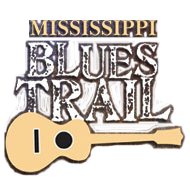Elvis Presley
Elvis Presley - Tupelo
Elvis Presley revolutionized popular music by blending the blues he first heard as a youth in Tupelo with country, pop, and gospel. Many of the first songs Elvis recorded for the Sun label in Memphis were covers of earlier blues recordings by African Americans, and he continued to incorporate blues into his records and live performances for the remainder of his career.
Elvis first encountered the blues here in Tupelo, and it remained central to his music throughout his career. The Presley family lived in several homes in Tupelo that were adjacent to African American neighborhoods, and as a youngster Elvis and his friends often heard the sounds of blues and gospel streaming out of churches, clubs, and other venues. According to Mississippi blues legend Big Joe Williams, Elvis listened in particular to Tupelo blues guitarist Lonnie Williams.
During Elvis’s teen years in Memphis he could hear blues on Beale Street, just a mile south of his family’s home. Producer Sam Phillips had captured many of the city’s new, electrified blues sounds at his Memphis Recording Service studio, where Elvis began his recording career with Phillips’s Sun label. Elvis was initially interested in recording ballads, but Phillips was more excited by the sound created by Presley and studio musicians Scotty Moore and Bill Black on July 5, 1954, when he heard them playing bluesman Arthur “Big Boy” Crudup’s 1946 recording “That’s All Right.”
That song appeared on Presley’s first single, and each of his other four singles for Sun Records also included a cover of a blues song—Arthur Gunter’s “Baby Let’s Play House,” Roy Brown’s “Good Rockin’ Tonight,” Little Junior Parker’s “Mystery Train,” and Kokomo Arnold’s “Milk Cow Blues,” recorded under the title “Milkcow Blues Boogie” by Elvis, who likely learned it from a version by western swing musician Johnnie Lee Wills. Elvis’s sound inspired countless other artists, including Tupelo rockabilly musician Jumpin’ Gene Simmons, whose 1964 hit “Haunted House” was first recorded by bluesman Johnny Fuller.
Elvis continued recording blues after his move to RCA Records in 1955, including “Hound Dog,” first recorded by Big Mama Thornton in 1952, Lowell Fulson’s “Reconsider Baby,” Big Joe Turner’s “Shake, Rattle and Roll,” and two more by Crudup, “My Baby Left Me” and “So Glad You’re Mine.” One of Elvis’s most important sources of material was the African American songwriter Otis Blackwell, who wrote the hits “All Shook Up,” “Don’t Be Cruel,” and “Return to Sender.” In Presley’s so-called “comeback” appearance on NBC television in 1968, former bandmates Scotty Moore and D. J. Fontana rejoined him as he reprised his early Sun recordings and performed other blues, including the Jimmy Reed songs “Big Boss Man” and “Baby What You Want Me to Do.” Blues remained a feature of Elvis’s live performances until his death his 1977.
content © Mississippi Blues Commission
[ BACK TO TOP ]

